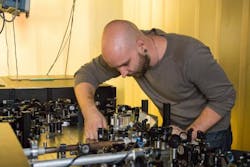A midinfrared ultrafast laser developed by electrical engineers at the Photonics Institute, Vienna University of Technology (TU Wien; Vienna, Austria) and Max-Born-Institut für Nichtlineare Optik und Kurzzeitspektroskopie (Berlin, Germany) has drastically increased the flux of hard x-ray photons from a tabletop laser-driven x-ray source.1
X-rays are used whenever the atomic structure of materials has to be investigated. As the new x-ray source does not produce a continuous beam but short pulses, it can be used for time-resolved measurements.
The 4 μm light emitted by the laser hits a copper plate; the intensity of the sub-100-fs laser pulses is so high that electrons are ripped out of the atoms. The laser field turns them around, accelerates them, and eventually makes them hit the copper again at very high energies. Upon impact of the electrons returning to the copper plate, X-ray radiation is emitted.
“The flux of the x-ray radiation depends on the wavelength of the laser.” says Skirmantas Alisauskas (TU Wien). “If the laser wavelength is long, then every electron spends a lot of time in the laser field before it returns to the copper atoms. It has more time to gain energy and hits the copper plate even harder. Previously, this experiment was done with a common 0.8 μm laser. The wavelength of our laser pulses is five times as long, which translates into a 25-times-higher x-ray flux.”
Each laser pulse leads to one billion x-ray photons, emitted into all directions.
“At this wavelength, this is the most intense laser light in the world," says Alisauskas. "But we want to go even further in the near future.” The team is planning to go to longer wavelengths, and they are trying to increase the pulse-repetition rate of the laser.
Source: http://www.tuwien.ac.at/en/news/news_detail/article/9085/
REFERENCE:
1. Jannick Weisshaupt et al., Nature Photonics (2014); doi: 10.1038/nphoton.2014.256

